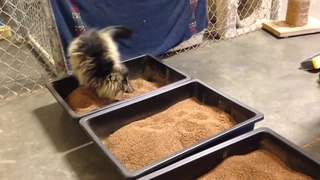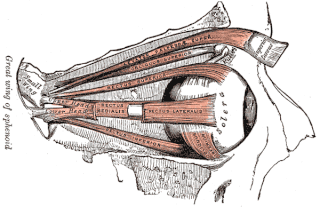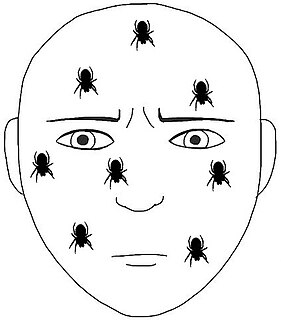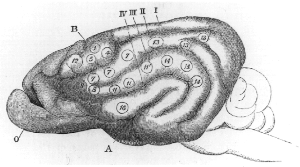
A phantom limb is the sensation that an amputated or missing limb is still attached. Approximately 80 to 100% of individuals with an amputation experience sensations in their amputated limb. However, only a small percentage will experience painful phantom limb sensation. These sensations are relatively common in amputees and usually resolve within two to three years without treatment. Research continues to explore the underlying mechanisms of phantom limb pain (PLP) and effective treatment options.

Vilayanur Subramanian Ramachandran is an Indian-American neuroscientist. Ramachandran is known for his wide-ranging experiments and theories in behavioral neurology, including the invention of the mirror box. He is a Distinguished Professor in UCSD's Department of Psychology, where he is the director of the Center for Brain and Cognition.

The parietal lobe is one of the four major lobes of the cerebral cortex in the brain of mammals. The parietal lobe is positioned above the temporal lobe and behind the frontal lobe and central sulcus.
Cortical maps are collections (areas) of minicolumns in the brain cortex that have been identified as performing a specific information processing function.

The barrel cortex is a region of the somatosensory cortex that is identifiable in some species of rodents and species of at least two other orders and contains the barrel field. The 'barrels' of the barrel field are regions within cortical layer IV that are visibly darker when stained to reveal the presence of cytochrome c oxidase and are separated from each other by lighter areas called septa. These dark-staining regions are a major target for somatosensory inputs from the thalamus, and each barrel corresponds to a region of the body. Due to this distinctive cellular structure, organisation, and functional significance, the barrel cortex is a useful tool to understand cortical processing and has played an important role in neuroscience. The majority of what is known about corticothalamic processing comes from studying the barrel cortex, and researchers have intensively studied the barrel cortex as a model of neocortical column.

Mirror therapy (MT) or mirror visual feedback (MVF) is a therapy for pain or disability that affects one side of the patient more than the other side. It was invented by Vilayanur S. Ramachandran to treat post-amputation patients who suffered from phantom-limb pain (PLP). Ramachandran created a visual illusion of two intact limbs by putting the patient's affected limb into a "mirror box," with a mirror down the center.
Phantom pain is a perception that an individual experiences relating to a limb or an organ that is not physically part of the body. Limb loss is a result of either removal by amputation or congenital limb deficiency. However, phantom limb sensations can also occur following nerve avulsion or spinal cord injury.
Neuroplasticity, also known as neural plasticity, or brain plasticity, is the ability of neural networks in the brain to change through growth and reorganization. These changes range from individual neuron pathways making new connections, to systematic adjustments like cortical remapping. Examples of neuroplasticity include circuit and network changes that result from learning a new ability, environmental influences, practice, and psychological stress.

The human secondary somatosensory cortex is a region of cortex in the parietal operculum on the ceiling of the lateral sulcus.

The Silver Spring monkeys were 17 wild-born macaque monkeys from the Philippines who were kept in the Institute for Behavioral Research in Silver Spring, Maryland. From 1981 until 1991, they became what one writer called the most famous lab animals in history, as a result of a battle between animal researchers, animal advocates, politicians, and the courts over whether to use them in research or release them to a sanctuary. Within the scientific community, the monkeys became known for their use in experiments into neuroplasticity—the ability of the adult primate brain to reorganize itself.
The zona incerta (ZI) is a horizontally elongated region of gray matter in the subthalamus below the thalamus. Its connections project extensively over the brain from the cerebral cortex down into the spinal cord.

The phantom eye syndrome (PES) is a phantom pain in the eye and visual hallucinations after the removal of an eye.
Michael Matthias Merzenich is a professor emeritus neuroscientist at the University of California, San Francisco. His contributions to the field are numerous. He took the sensory cortex maps developed by his predecessors and refined them using dense micro-electrode mapping techniques. Using this, he definitively showed there to be multiple somatotopic maps of the body in the postcentral sulcus, and multiple tonotopic maps of the acoustic inputs in the superior temporal plane.
Body schema is a concept used in several disciplines, including psychology, neuroscience, philosophy, sports medicine, and robotics. The neurologist Sir Henry Head originally defined it as a postural model of the body that actively organizes and modifies 'the impressions produced by incoming sensory impulses in such a way that the final sensation of body position, or of locality, rises into consciousness charged with a relation to something that has happened before'. As a postural model that keeps track of limb position, it plays an important role in control of action. It involves aspects of both central and peripheral systems. Thus, a body schema can be considered the collection of processes that registers the posture of one's body parts in space. The schema is updated during body movement. This is typically a non-conscious process, and is used primarily for spatial organization of action. It is therefore a pragmatic representation of the body’s spatial properties, which includes the length of limbs and limb segments, their arrangement, the configuration of the segments in space, and the shape of the body surface. Body schema also plays an important role in the integration and use of tools by humans.

The somatosensory system is a part of the sensory nervous system that is associated with the sense of touch, but includes parallel receptors and nerve pathways for the sensations of temperature, body position and movement, and pain. This complex system of sensory neurons, and neural pathways responds to changes at the surface of, or inside, the body. The axons of sensory neurons connect with, or respond to, various receptor cells. These sensory receptor cells are activated by different stimuli such as heat and nociception, giving a functional name to the responding sensory neuron, such as a thermoreceptor which carries information about temperature changes. Other receptor types include mechanoreceptors, chemoreceptors, and nociceptors which send signals along a sensory nerve to the spinal cord, where the signals may be processed by other sensory neurons, and then relayed to the brain for further processing. Sensory receptors are found all over the body including the skin, epithelial tissues, muscles, bones and joints, internal organs, and the cardiovascular system.
Sensory maps are areas of the brain which respond to sensory stimulation, and are spatially organized according to some feature of the sensory stimulation. In some cases the sensory map is simply a topographic representation of a sensory surface such as the skin, cochlea, or retina. In other cases it represents other stimulus properties resulting from neuronal computation and is generally ordered in a manner that reflects the periphery. An example is the somatosensory map which is a projection of the skin's surface in the brain that arranges the processing of tactile sensation. This type of somatotopic map is the most common, possibly because it allows for physically neighboring areas of the brain to react to physically similar stimuli in the periphery or because it allows for greater motor control.
Sensory stimulation therapy (SST) is an experimental therapy that aims to use neural plasticity mechanisms to aid in the recovery of somatosensory function after stroke or cognitive ageing. Stroke and cognitive ageing are well known sources of cognitive loss, the former by neuronal death, the latter by weakening of neural connections. As SS implies a patient will have a desired sense stimulated in a predetermined fashion at a known frequency. It has been found that this technique can be used to reduce as much as 30 years of cognitive ageing, and can both improve two point discrimination thresholds and also impair them.

Restorative neurology is a branch of neurology dedicated to improving functions of the impaired nervous system through selective structural or functional modification of abnormal neurocontrol according to underlying mechanisms and clinically unrecognized residual functions. When impaired, the body naturally reconstructs new neurological pathways and redirects activity. The field of restorative neurology works to accentuate these new pathways and primarily focuses on the theory of the plasticity of an impaired nervous system. Its main goal is to take a broken down and disordered nervous system and return it to a state of normal function. Certain treatment strategies are used to augment instead of fully replace any performance of surviving and also improving the potential of motor neuron functions. This rehabilitation of motor neurons allows patients a therapeutic approach to recovery opposed to physical structural reconstruction. It is applied in a wide range of disorders of the nervous system, including upper motor neuron dysfunctions like spinal cord injury, cerebral palsy, multiple sclerosis and acquired brain injury including stroke, and neuromuscular diseases as well as for control of pain and spasticity. Instead of applying a reconstructive neurobiological approach, i.e. structural modifications, restorative neurology relies on improving residual function. While subspecialties like neurosurgery and pharmacology exist and are useful in diagnosing and treating conditions of the nervous system, restorative neurology takes a pathophysiological approach. Instead of heavily relying on neurochemistry or perhaps an anatomical discipline, restorative neurology encompasses many fields and blends them together.

Tactile hallucination is the false perception of tactile sensory input that creates a hallucinatory sensation of physical contact with an imaginary object. It is caused by the faulty integration of the tactile sensory neural signals generated in the spinal cord and the thalamus and sent to the primary somatosensory cortex (SI) and secondary somatosensory cortex (SII). Tactile hallucinations are recurrent symptoms of neurological diseases such as schizophrenia, Parkinson's disease, Ekbom's syndrome and delerium tremens. Patients who experience phantom limb pains also experience a type of tactile hallucination. Tactile hallucinations are also caused by drugs such as cocaine and alcohol.

Limb telescoping is the progressive shortening of a phantom limb as the cortical regions are reorganized following an amputation. During this reorganization, proximal portions of the residual limb are perceived as more distal parts of the phantom limb. Such effect is responsible for increased phantom pain due to the discrepancy between the patient’s body perception and their actual body. This effect may last from weeks up to years after post-amputation.














